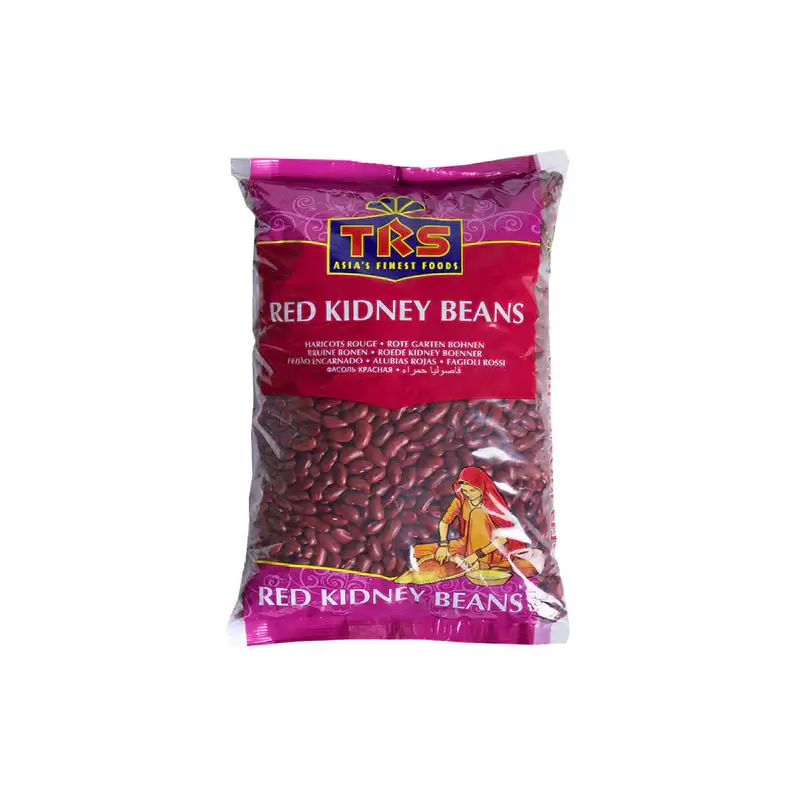- Dry Furits
- Deal Of The Month
- Diwali Collection´s
- Biscuits, Cookies & Rusk
- Cool & Frozen
- Instant Food
- Desserts
- Milk Products
- Tea
- Wheat/ Chapati Flour
- Puja, Worship Items
- Beverages
- Snacks
- Sweets
- Pickles & Sauces
- Grains & Flour Mixes
- Spices & Condiments
- Basmati Rice/ South Indian RIce
- Home
- Sale
- Others
- Best selling
TRS Red Kidney Beans, also known as Rajma in Hindi, are a popular type of legume widely used in Indian, Mexican, and other global cuisines. Known for their deep red color and kidney-like shape, these beans are valued for their rich flavor and nutritional benefits.
What are Red Kidney Beans?
Red Kidney Beans (Phaseolus vulgaris) are large, dark red beans with a firm texture. They hold their shape well when cooked, making them ideal for use in soups, stews, salads, and various bean dishes.
Nutritional Value
Red kidney beans are highly nutritious, offering a rich source of plant-based protein, dietary fiber, and essential vitamins and minerals such as iron, potassium, and folate. They are also low in fat and have a low glycemic index, making them a good choice for blood sugar management.
Preparation and Cooking
Soaking: Kidney beans must be soaked before cooking. This reduces cooking time and helps to remove some of the complex sugars that can cause digestive discomfort. Soak the beans in plenty of water for at least 6-8 hours or overnight.
Cooking: After soaking, drain and rinse the beans. Cook them in fresh water either on the stovetop, in a pressure cooker, or in an instant pot. They typically take about 45 minutes to an hour to cook on the stovetop, or around 15-20 minutes in a pressure cooker. Ensure the beans are fully cooked, as undercooked kidney beans can be toxic due to a compound called phytohemagglutinin.
Culinary Uses
Rajma: In Indian cuisine, red kidney beans are most famously used in Rajma, a hearty and flavorful curry made with tomatoes, onions, and a blend of spices. It’s usually served with rice (Rajma Chawal) or roti.
Chili: In Mexican and American cuisine, kidney beans are a key ingredient in chili con carne, a spicy stew made with ground meat, tomatoes, and chili peppers.
Salads: Cooked kidney beans can be added to salads, providing a boost of protein and fiber.
Soups and Stews: Kidney beans are commonly used in various soups and stews, adding texture and a rich, earthy flavor.
Rice and Beans: They are often paired with rice in Caribbean and Latin American dishes.
Cooking Tips
Don’t Add Salt Initially: When cooking kidney beans, avoid adding salt or acidic ingredients (like tomatoes or vinegar) until the beans are nearly tender. Adding these too early can prevent the beans from softening properly.
Flavoring: Kidney beans absorb flavors well. Use a variety of spices and herbs like cumin, coriander, garlic, bay leaves, and thyme to enhance their taste.
Consistency: For creamier dishes like Rajma, mash a few beans against the side of the pot to thicken the sauce.
Storage
Dry Kidney Beans: Store in an airtight container in a cool, dry place. They can be stored for up to a year.
Cooked Beans: Once cooked, kidney beans can be stored in the refrigerator for 3-4 days or frozen for longer storage.
Health Benefits
High in Protein and Fiber: Excellent source of plant-based protein and dietary fiber, aiding in muscle repair, digestion, and maintaining satiety.
Rich in Antioxidants: Kidney beans are high in antioxidants, which help protect the body from free radical damage.
Heart Health: The high fiber content helps lower cholesterol levels, supporting heart health.
TRS Red Kidney Beans are a versatile ingredient that can be incorporated into a wide range of dishes. If you’re looking for specific recipes or additional tips on cooking with kidney beans, feel free to ask!








